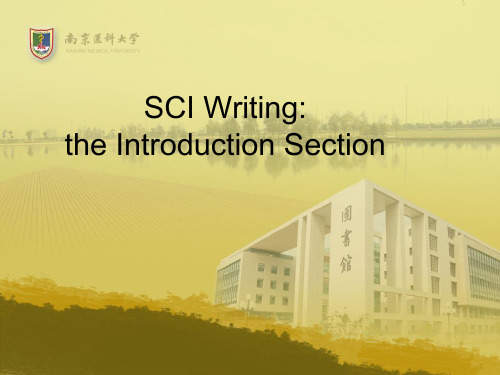Introduction(医学论文写作及国际会议交流)
- 格式:pptx
- 大小:3.36 MB
- 文档页数:34

SCI论文引言部分Introduction的写作第一篇:SCI论文引言部分Introduction的写作SCI论文引言部分Introduction的写作引言Introduction 是SCI论文最难写的部分之一,很多文章的缺陷就在于Introduction没有内涵,过于简单,没有真正体现论文的研究起初和创新要素,然而,一篇好的SCI论文对于Introduction的要求是非常高的,一个好的引言相当于文章成功了一半。
所以大家应该在 Introduction的撰写上下功夫。
要写好 Introduction,最重要的是要保持鲜明的层次感和极强的逻辑性,这两点是紧密结的,即在符合逻辑性的基础上建立层层递进的关系。
SCI论文引言部分Introduction 主要包括如下四个方面的内容:1、阐述自己研究领域的基本内容。
要尽量简洁明了,不罗嗦;须知看文章者都是该领域的专家,所以一些显而易见的知识要用概括性的而不是叙述性的语言来描述。
2、文献总结回顾。
是引言的重头戏之一,要特别着重笔墨来描写。
一方面要把该领域内过去和现在的状况全面概括总结出来,不能有丝毫的遗漏,特别是最新的进展和过去经典文献的引用(这是两个最容易出问题的地方,要极力避免;一旦审稿人指出这两个毛病,很可能意味着表明你做的不够深入或全面,负面作用非常明显)。
另一方面,文献引用和数据提供一定要准确,切记避免片面摘录部分结果而不反映文献的总体结果;引用的数据也要正确,特别是间接引用的数据(即不是从原文献中查到,而是从别人文献中发现的另一篇文献的数据);数据出错会导致文章的印象特差!此外,引用文献时注意防止造成抄袭的印象,即不要原文抄录,要用自己的话进行总结描述。
如果审稿人正好是文献的引用者的话,原文照抄的结果一定会很糟糕。
3、分析过去研究的局限性并阐明自己研究的创新点。
这是整个引言的高潮,因而要慎之又慎。
阐述局限性时,需要客观公正评价别人的工作,不要把抬高自己研究的价值建立在贬低别人的工作之上(这也是文章易犯的毛病),研究者一定要遵循实事求是的原则来分析。


introduction范文英文回答:The concept of synthetic biology, a burgeoning field that harnesses the power of engineering principles to manipulate biological systems, has emerged as a transformative force with the potential to revolutionize diverse sectors of our society. This field of study, which lies at the intersection of engineering, biology, and computer science, empowers scientists and engineers to design and reengineer biological systems, paving the wayfor the creation of novel biological devices and systems with unprecedented functionalities.Central to the field of synthetic biology is the notion of taking a modular approach to biological design, akin to the manner in which electronic circuits are constructed. This involves breaking down complex biological systems into their constituent components, such as DNA, proteins, and other molecules, and then reassembling them in novel waysto achieve desired outcomes. By leveraging standardized biological parts, researchers can mix and match componentsto create new biological systems, offering a level ofcontrol and precision that was previously unattainable.The potential applications of synthetic biology arevast and multifaceted, spanning industries as diverse as healthcare, energy, and manufacturing. Within the realm of healthcare, synthetic biology holds promise for the development of personalized medicine, enabling thetailoring of treatments to individual patients based ontheir unique genetic profiles. Additionally, synthetic biology could pave the way for the creation of novel vaccines, drugs, and therapies to combat a wide range of diseases.In the energy sector, synthetic biology offerstantalizing prospects for the development of sustainableand renewable energy sources. Researchers are exploring the use of synthetic biology to optimize the efficiency of photosynthesis, engineer microorganisms to produce biofuels, and develop novel bio-based materials for energy storageand conversion.Within the manufacturing domain, synthetic biology presents opportunities for the creation of sustainable and cost-effective production processes. Scientists are harnessing the power of synthetic biology to engineer microorganisms for the production of chemicals, materials, and other valuable products, potentially reducing the reliance on fossil fuels and promoting a more circular economy.The transformative potential of synthetic biology is undeniable, yet it is essential to approach its development and applications with a nuanced understanding of its ethical, legal, and societal implications. Careful consideration must be given to issues such as biosafety, intellectual property rights, and the potential impact on ecosystems and biodiversity.As the field of synthetic biology continues to advance, it is imperative that researchers, policymakers, and the general public engage in a robust dialogue to shape thefuture of this transformative technology. Through open and collaborative discussions, we can harness the power of synthetic biology to address societal challenges, improve human health, and foster a sustainable future while safeguarding the principles of ethics, responsibility, and equity.中文回答:合成生物学是一个新兴领域,它利用工程原理来操纵生物系统,它已经成为一种变革力量,有可能彻底改变我们社会的各个领域。



Abstract一、在摘要中直接提出论文主题的句型和句式1、In this paper,we present a… approach to…本文提出了一种针对…的…方法。
2、In this paper,we describe improved… models for…本文介绍几种针对…的改进的…模型。
3、We propose a new… model and…algorithm that enables us to…我们提出一种新的…模型和…算法,它让我们能够…4、We present a…model that enables…我们提出了一种…模型,它使我们能够…5、This paper demonstrates the ability of …to perform robust and accurate…本文证明了…进行…可靠准确的…的能力。
6、In this paper we report results of a…approach to…本文报导了…的…方法的实验结果。
7、This paper demonstrates that…can effectively…with very high accuracy.本文证明,…能够有效地准确地…8、The purpose/goal/intention/objective/object/emphasis/aim of this paper is…本文的目的是…9、The primary/chief/overall/main object of this study is to survey…本研究的首要目标是考察…10、The chief aim of this paper/research/study/experiment/the present work is…本文的主要目标是…11 、The emphasis of this study lies in …我们的研究重点是…12、The work presented in this paper focuses on…本文所述工作重点放在…13、Our goal has been to provide…我们的目标是提供…14、The main objective of our investigation has been to obtain some knowledge of …我们的研究目标是获取有关…的知识。
撰写英文医学科研论文的格式和要求一:格式二:要求三、标题与标题页1.格式根据医学杂志编辑国际委员会(The International Committee of Medical Journal Editors, ICMJE)制定的《生物医学杂志投稿统一要求》(The Uniform Requirements for Manuscripts Submitted to Biomedical Journals, 5th Ed., 1997)*, 一篇生物医学科研论文(以下简称“论文”)应包括以下12个部分:1.标题(Title)2.摘要(Abstract)3.引言(Introduction)4.材料与方法(Materials and Methods )5.结果(Results)6.讨论(Discussion)7.致谢(Acknowledgements)8.参考文献(References)9.插图说明(Legends)10.插图(Figures)11.表格(Tables)12.照片和说明(Plates and Explanations)以上除7、9、10、11、12部分因实际情况不需要外,其他各部分是一篇论文必不可少的内容。
下面分别介绍对各部分的基本要求,其中“标题”和“摘要”两部分将在以后单元另行讨论。
二.要求1)引言部分总的要求是:说明研究的总体范围和目的。
具体内容包括:A 背景–说明所研究问题的目前总体情况或历史B 意义–说明研究的意义或必要性C 进展–说明有关该问题的先有发现、报告或研究。
陈述这部分内容时一般要有引文D 目的–说明本研究的目的E 范围–说明要研究问题的具体范围2)材料与方法部分总的要求是:结果的可重演性、方法的可靠性以及前后的逻辑性。
具体内容包括:A.简要说明研究设计,如:回顾(retrospective / review),前瞻(prospective),临床(clinical),动物(animal),实验(experimental)等研究性质;B. 详细说明研究对象情况,包括研究人员(student),被研究的人(client)和动物(animal)的性别(sex)、年龄(age),物种(species),品种(breed)生理状态(physiological state); 微生物则要说明其菌株(strain),血清型(serotype)及其他区别特性(identity characteristics);C. 随机分组分组方法(methods of any random assignment of subjects to groups)和选择标准(criteria for admission to study groups);D. 详细说明所用的药物(drug),激素(hormone),试剂(reagent)和其他化学品(chemical)的名称、商标(trademark)、生产厂家(manufacturer)及所在地(location);E. 简要说明测定方法(method of measurement),包括名称,引文和偏差(variations);F. 简要说明统计学分析方法(method of statistic analysis)这部分的陈述程序一般为:研究设计→研究对象性质→处理/ 干预方法→测定/ 观察手段→统计分析除指示性说明外,如:“病人资料见表1”(Data of the patients are shown in Table 1)“材料与方法”和“结果”两部分一律用过去时表达。
怎样写好英文论文的Introduction部分?在论文写作过程中,很多同学搞不清abstract和introduction的区别,认为这两个部分都是一样的,由于概念的模糊导致introduction的写作存在问题。
那么什么是introduction,又应该怎么写这一部分呢?摘要我们都知道主要是对文章内容从选题背景,主要内容和研究问题三个部分来概述。
而Introduction部分是要求内容在对应的选题上更加精确,即通过承接摘要部分提出的内容来展开话题,从比较宏观的学术背景逐渐过渡到本文的研究课题来说服目标读者。
Introduction部分需要明确呈现的三个部分:一是background;二是research gap;三是study purpose。
总的来说,就是从what is known到what is unknown最后推出自己的研究问题。
所以Introduction一开始要陈述的是自己研究课题领域的大背景和重要性,第一部分的主要目的是向读者展示自己选择的研究方向前人有过那些经典的理论和实验,证明你对这个领域已经有全面客观的了解。
这样才能向第二部分进行。
第二部分即找到课题领域的研究空白。
所谓空白,包括尚未设涉及的问题和前人没有研究透彻或者随着该领域发展一些需要理论或实验需要进行进一步修正。
这些都可以作为你了解到的研究空白,同时为你接下来的选题陈述奠定基础。
接下来就是要基于前两个部分的陈述点出本文的研究课题、研究意义和采用的研究方法。
写Introduction有几个需要注意的问题:首先在字数上不要过多,尤其在概述背景的部分,不要堆砌罗列文献,要选择与自己选题密切相关的著作或著名理论来陈述。
其次要时刻记得Introduction的目的是要让读者通过对这一部分的阅读对你的研究产生兴趣,即吸引读者。
Introduction属于论文中最难写的部分之一,这一部分的成败直接影响到你整篇论文的质量。
所以要在初稿完成后反复修改,不要过多赘述也不要一带而过。